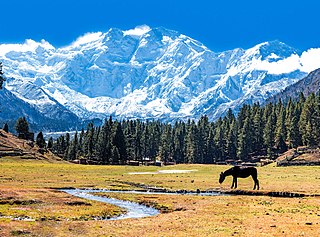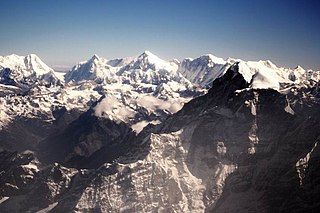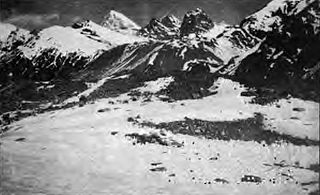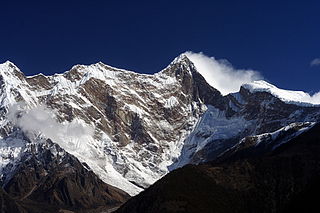
The International Mountaineering and Climbing Federation or UIAA recognise eight-thousanders as the 14 mountains that are more than 8,000 metres (26,247 ft) in height above sea level, and are considered to be sufficiently independent from neighbouring peaks. However, there is no precise definition of the criteria used to assess independence, and since 2012 the UIAA has been involved in a process to consider whether the list should be expanded to 20 mountains. All eight-thousanders are located in the Himalayan and Karakoram mountain ranges in Asia, and their summits are in the death zone.

The Dhaulagiri massif in Nepal extends 120 km (70 mi) from the Kaligandaki River west to the Bheri. This massif is bounded on the north and southwest by tributaries of the Bheri River and on the southeast by the Myagdi Khola. Dhaulagiri is the seventh highest mountain in the world at 8,167 metres (26,795 ft) above sea level, and the highest mountain within the borders of a single country (Nepal). It was first climbed on 13 May 1960 by a Swiss/Austrian/Nepali expedition.

Nanga Parbat, locally known as Diamer, is the ninth highest mountain in the world at 8,126 metres (26,660 ft) above sea level. Located in the Diamer District of the Pakistani-administered Gilgit-Baltistan region of Kashmir, Nanga Parbat is the western anchor of the Himalayas. The name Nanga Parbat is derived from the Sanskrit words nanga and parvata which together mean "Naked Mountain". The mountain is locally known by its Tibetan name Diamer or Deo Mir, meaning "huge mountain".

Hermann Buhl was an Austrian mountaineer and is considered one of the best climbers of all time. He was particularly innovative in applying Alpine style to Himalayan climbing. His accomplishments include:

Gaurishankar is a mountain in the Himalayas, the second highest peak of the Rolwaling Himal, behind Melungtse (7,181m). The name comes from the Hindu goddess Gauri, a manifestation of Durga, and her Consort Shankar, denoting the sacred regard to which it is afforded it by the peoples of Tibet and Nepal. The Buddhist Sherpas call the mountain Jomo Tseringma. The Nepal Standard Time (GMT+05:45) is based on the meridian of this mountain peak.

Kamet is the second highest mountain in the Garhwal region of Uttarakhand, India, after Nanda Devi. It lies in the Chamoli District of Uttarakhand. Its appearance resembles a giant pyramid topped by a flat summit area with two peaks.

Alan Hinkes OBE is an English Himalayan high-altitude mountaineer from Northallerton in North Yorkshire. He is the first and remains the only, British mountaineer to claim all 14 Himalayan eight-thousanders, which he did on 30 May 2005.

Namcha Barwa or Namchabarwa is a mountain in the Tibetan Himalaya. The traditional definition of the Himalaya extending from the Indus River to the Brahmaputra would make it the eastern anchor of the entire mountain chain, and it is the highest peak of its own section as well as Earth's easternmost peak over 7,600 metres (24,900 ft).

Mont Forel is a mountain in King Christian IX Land, Sermersooq Municipality, Greenland. It is part of the Schweizerland range, also known as 'Schweizerland Alps'.

Mt. Satopanth (7075m) is one of the prominent peaks of the Garhwal range of Himalayas that politically fall in the Indian subcontinent and the also the second highest peak in Gangotri National Park. The nomenclature of the peak is derived by an amalgamation of two Sanskrit words “Sato” meaning ‘Truth’ and “Panth” meaning “A Figure of veneration or Devotion” when combined means {The True Figure of Devotion and Veneration}. The mountain was first climbed successfully by a Swiss expedition in the glorious Indian year of 1947 15 days prior to the Indian independence, the team was led by Andre Roch. Lately the mountain has become quite famous for its Pre-Everest expeditions, because of the variety of mature technicalities that she boasts of; like Her majestic altitude, the daunting ‘knife ridge’ at 6500m and some technical Ice and rock glacial negotiations at 5900 m. Satopanth is a mountain in the Gangotri region of the Garhwal Himalaya, in the Indian Himalayas. It lies in the northern Indian state of Uttarakhand.

The Mazeno Ridge is an arête, a long narrow ridge, and part of the Nanga Parbat massif in Gilgit–Baltistan, Pakistan, in the Himalayan range. The ridge is the longest of any ridge on the eight-thousand-metre peaks in the Himalayas. A series of eight subsidiary peaks form the ridge, the highest being Mareno Peak 7,120 metres (23,360 ft). All eight subsidiary peaks have been climbed, but a complete traverse of the ridge and ascent of Nanga Parbat was only successfully achieved in 2012, and as of 2019, no other expedition has reached the summit of Nanga Parbat via the Mazeno Ridge.

Bhagirathi Parbat II is a mountain in Uttarakhand India, its the 85th highest located entirely within the Uttarakhand India. Nanda Devi, is the highest mountain in this category. Its second highst peak in the Bhagirathi Massif. The summits is 6512 meter or 21365 feet. It was first climbed by Austrians Edi Ellmauthaler and Toni Messner in 1933.

Chandra Parbat I is a mountain of the Garhwal Himalaya in Uttarakhand India. Chandra Parbat I standing majestically at 6,739 metres (22,110 ft). It is 42nd highest located entirely within the Uttrakhand. Nanda Devi, is the highest mountain in this category. Chandra Parbat I lies on the eastern bank of the Suralaya Glacier. It is located in between Chandra II and Chandra III (South). It is located 4.9 km NE of Satopanth 7,075 metres (23,212 ft) and 8 km west lies Vasuki South 6,702 metres (21,988 ft). On the 7.4 km SWS lies the Swachhand Peak 6,721 metres (22,051 ft) and Bhgirathi Massif on the west side.

Matri is a mountain of the Garhwal Himalaya in Uttarakhand India. Matri standing majestically at 6,721 metres (22,051 ft). It is joint 46th highest located entirely within the Uttrakhand. Nanda Devi, is the highest mountain in this category. Matri lies between the Chaturbhuj 6,654 metres (21,831 ft) and Chirbas Parbat 6,529 metres (21,421 ft). Its nearest higher neighbor Sri Kailash lies 10.3 km east. It is located 4.6 km NW of Sudarshan Parbat 6,507 metres (21,348 ft) and 5.7 km NW lies Kalidhang 6,373 metres (20,909 ft).

Chirbas Parbat is a mountain of the Garhwal Himalaya in Uttarakhand India.The elevation of Chirbas Parbat is 6,529 metres (21,421 ft) and its prominence is 643 metres (2,110 ft). It is joint 81st highest located entirely within the Uttrakhand. Nanda Devi, is the highest mountain in this category. Chirbas Parbat lies between the Kalidhang 6,373 metres (20,909 ft) and Matri 6,721 metres (22,051 ft). Its nearest higher neighbor Matri lies 3 km SE. It is located 5.9 km NW of Chaturbhuj 6,654 metres (21,831 ft) and 13.8 km east lies Trimukhi Parbat 6,450 metres (21,161 ft).

Chaturbhuj (Hindi:चतुर्भुज) is a mountain of the Garhwal Himalaya in Uttarakhand India.The elevation of Chaturbhuj is 6,654 metres (21,831 ft) and its prominence is 357 metres (1,171 ft). It is 52nd highest located entirely within the Uttrakhand. Nanda Devi, is the highest mountain in this category. Chaturbhuj lies between the Matri 6,721 metres (22,051 ft) and Shwetvarn 6,340 metres (20,801 ft). Its nearest higher neighbor Yogeshwar lies 2.7 km east. It is located 5.9 km NW of chirbas Parbat 6,529 metres (21,421 ft) and 8.5 km east lies Sri Kailash 6,932 metres (22,743 ft).

Koteshwar I is a mountain of the Garhwal Himalaya in Uttarakhand India. The elevation of Koteshwar I is 6,080 metres (19,948 ft). It is 161 highest located entirely within the Uttrakhand. Nanda Devi, is the highest mountain in this category. It lies close to Sudarshan Parbat 6,507 metres (21,348 ft) in the south. It has two approach route one from Thely Bamak and another from Swetvarn Bamak. Its nearest higher neighbor Sudarshan Parbat 6,507 metres (21,348 ft) lies 1.3 km North. It is located 5 km SW of Yogeshwar 6,678 metres (21,909 ft) and 3.2 km east lies Shyamvarn 6,135 metres (20,128 ft).














